[ad_1]
Thanks to our Nature Community companion, Saturna Island Marine Analysis & Training Society (SIMRES), for sharing this informative weblog.
Whales of the Salish Sea
The Salish Sea, nestled within the inland waters of the Pacific Northwest, is a marine ecosystem wealthy in biodiversity. Its title acknowledges the Indigenous peoples from greater than 40 First Nations who converse the various totally different Coast Salish languages and have been the primary to dwell in and look after the realm. It spans the inland waters south of Campbell River between Vancouver Island and the mainland of British Columbia, to Puget Sound within the State of Washington.
The Salish Sea is residence to each toothed and baleen whales. Toothed whales, which embrace dolphins and porpoises, have enamel and actively hunt prey. They’re able to echolocating, which is the power to make use of sound and vibrations to navigate and find meals. Baleen whales can’t echolocate and have plates of their mouth which filter meals as they soak up water to feed. These plates are product of the identical protein that makes human hair.
Killer whales (additionally referred to as orcas) are the outstanding residents of the Salish Sea. There are two totally different ecotypes of killer whales within the Salish Sea: Bigg’s (additionally referred to as Transients) and Residents. Whereas totally different ecotypes of killer whales are the identical species, they don’t socialize or breed collectively, have totally different diets, and might look fairly totally different to a skilled eye. Resident killer whales eat fish and dwell in massive familial teams referred to as pods, whereas Bigg’s killer whales predominantly prey on different marine mammals and sometimes reside in smaller teams. The 2 distinct populations of Resident killer whales within the Salish Sea are the Northern Residents and the Southern Residents.
Humpback whales are probably the most frequent baleen whales noticed within the Salish Sea and can go to the realm throughout their migration routes between their summer time feeding grounds within the north and their winter birthing grounds within the south. Gray whales will sometimes come into the Salish Sea throughout their migration routes, although not as generally because the humpbacks. Some widespread minke whales spend their summers within the Salish Sea, usually close to the San Juan Islands.
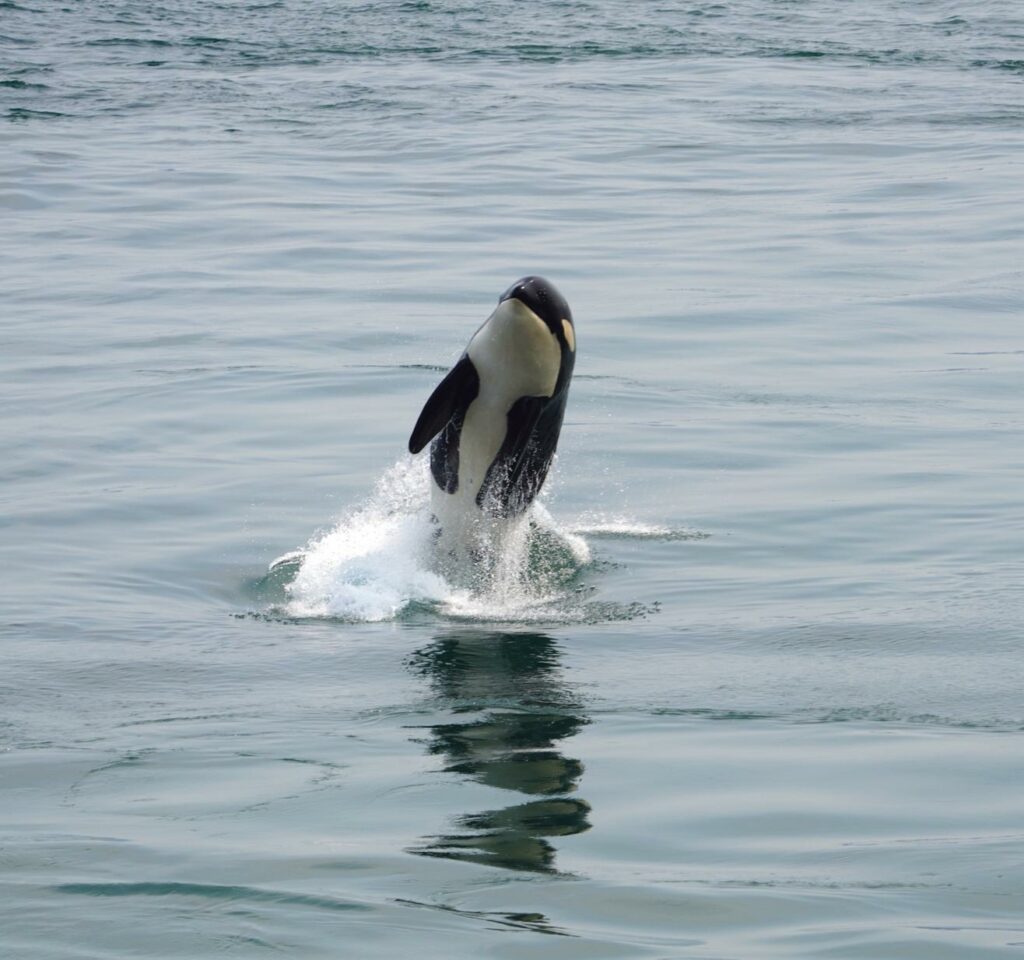
Southern Resident killer whale breaching off the coast of Saturna Island. Photograph Credit score: Lauren Laturnus.
Conservation Standing
Within the Nineteen Sixties and 70s, many killer whales have been captured for show in marine parks, inflicting hurt to particular person whales and wild populations. The Southern Resident killer whale inhabitants suffered large loss and declined to solely 71 people. Though the inhabitants elevated briefly, peaking at 98 people within the mid-90s, it quickly and severely declined once more to 78 people by 2001. As of July 2023, there have been 75 Southern Resident killer whales, and they’re listed as Endangered in Canada. Northern Residents, whereas additionally impacted by captures and prey decline, have skilled a gradual enhance in inhabitants dimension for the reason that Seventies and are at present listed as Threatened. Capturing or breeding whales is now unlawful in Canada.
The inhabitants of Bigg’s killer whales and their presence within the Salish Sea has elevated lately. That is possible because of the restoration of their prey species, notably the harbour seal which started to get well after searching rules have been carried out within the Seventies. Regardless of the latest enhance, Bigg’s killer whales are nonetheless listed as Threatened below the Species at Danger Act (SARA) and their inhabitants just isn’t thought-about steady.
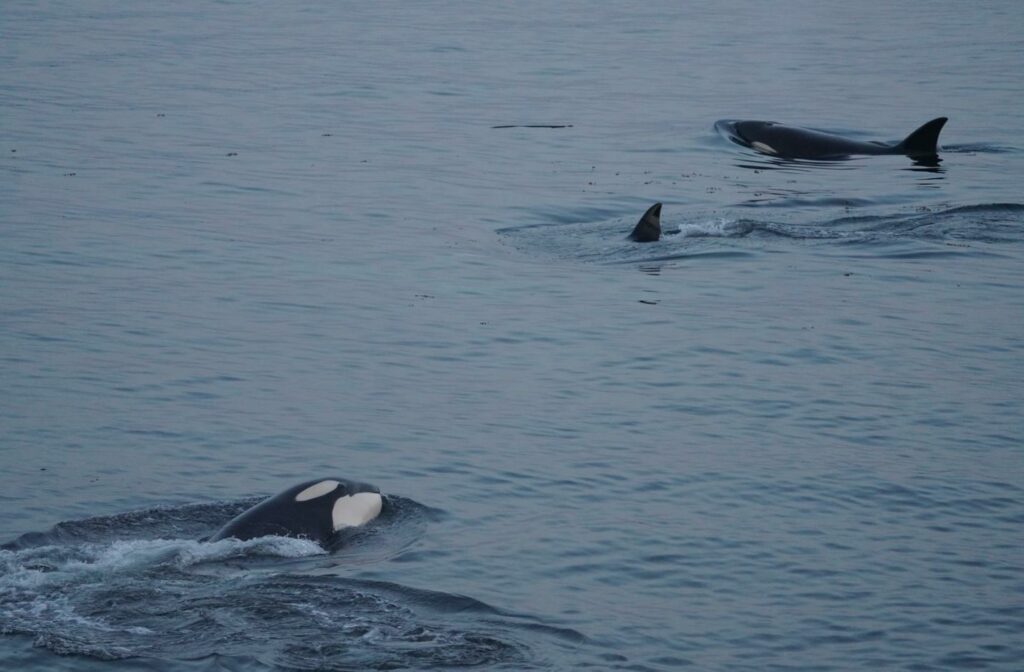
Bigg’s killer whales within the Saturna Island Interim Sanctuary Zone. Photograph Credit score: Mikayla Younger
Up to now, industrial whaling posed a menace to baleen whales like humpback and gray whales for hundreds of years. Nevertheless, after industrial whaling was halted in 1966, lots of their populations started to get well. Whereas humpbacks have made a noticeable return to the Salish Sea for the reason that late 2000s, the North Pacific inhabitants is listed as a Species of Particular Concern in Canada. Frequent minke whales and the Northern Pacific migratory inhabitants of gray whales are at present deemed not in danger.
Hazards for Whales within the Salish Sea
One could marvel why killer whales and humpbacks are nonetheless listed as Species at Danger despite the fact that seize for leisure and industrial whaling is now unlawful. The principle contributors to their decline are prey availability (meals), noise and bodily vessel disturbance, in addition to environmental contaminants.
What do these whales eat? Chinook salmon are the important thing prey species for Northern and Southern Resident killer whales, and their survival is intently linked with the abundance of Chinook which declined sharply within the mid-90s and has remained low ever since. To make issues worse, the southern a part of the Salish Sea is among the busiest delivery routes on the earth. The marine visitors right here additionally contains leisure boaters who benefit from the magnificent fantastic thing about the area. The full variety of vessels produces a number of underwater noise! This makes it more and more troublesome, particularly for the Southern Resident killer whales, to search out their prey because of the noise from vessels interfering with their capacity to echolocate and talk with one another.
Moreover, vessels pose a bodily menace to whales as collisions with them usually lead to critical harm or dying. That is notably regarding for baleen whales, as they can’t echolocate and could also be much less conscious of vessel presence round them. The presence of vessels has additionally been noticed to have an effect on whale behaviour, reminiscent of reducing the period of time spent foraging and beach-rubbing, a singular behaviour of the Northern Residents.
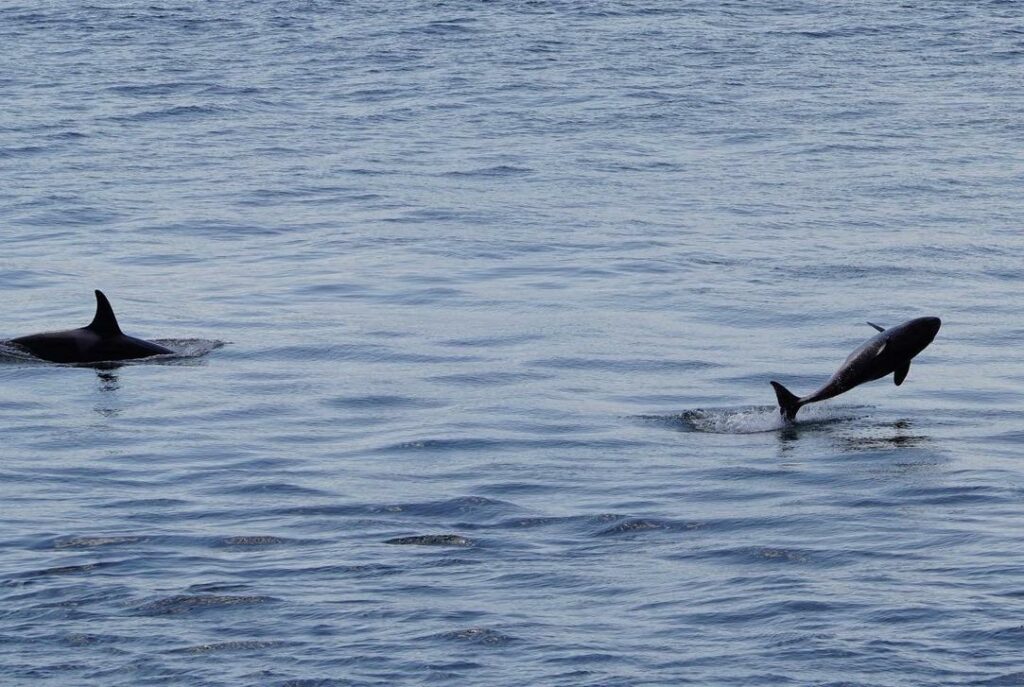
Southern Resident killer whale calf born in 2022 generally known as J59 or Sxwyeqólh (pronounced Swee-a-kosh) breaching out of the water forward of her mom J37 or Hy’Shqa (pronounced HY-shka) in June 2023. Photograph credit score: Rachel Fairfield Checko
Working Collectively to Save the Whales
To help the restoration of Southern Resident killer whales, the Canadian authorities carried out administration measures, together with fishing restrictions and vessel visitors rules. One measure designed to deal with vessel impacts was establishing two Interim Sanctuary Zones (ISZ) positioned off Pender Island and Saturna Islands. Since 2019, they’ve been in impact from June 1st to November 30th. Vessels are prohibited from travelling or fishing inside these areas, with very restricted exceptions. These areas have been chosen attributable to their historic significance as essential foraging grounds for the Southern Resident killer whales.
In 2012, a bunch of residents from Saturna Island who have been involved concerning the well being of the marine ecosystem within the Salish Sea got here collectively to kind the Saturna Island Marine Analysis and Training Society (SIMRES). In the present day, they’re a profitable non-profit group and have sponsored the Southern Gulf Islands Whale Sightings Community (SGIWSN), a citizen-led group with skilled volunteers from Saturna, Pender, Mayne, and Galiano Islands who acquire information on whales and monitor vessels within the ISZs.
The Saturna ISZ runs alongside the coast of East Level, a well-liked island vacation spot within the Gulf Island Nationwide Park Reserve and the most effective locations on the earth to look at whales from shore. The shore has exceptional depth, enabling whales to strategy very near land. The ISZ and surrounding waters additionally function a vital ecosystem for Bigg’s killer whales and humpback whales, which ceaselessly journey and forage inside it. Every so often, a minke or gray whale has additionally paid a go to to East Level to say whats up. Not surprisingly, East Level is a superb place for analysis and the Saturna ISZ is among the few locations within the Salish Sea the place there are totally different strategies – each automated and handbook – used to detect whales and vessels.
Analysis is certainly taking place! Since 2020 grasp’s college students within the lab of Dr. Ruth Pleasure at Simon Fraser College (SFU) have collaborated with SIMRES and SGIWSN to conduct analysis and monitor the Saturna Island ISZ which has a great view of Boundary Go, the Southern Strait of Georgia, and a big portion of the ISZ. These college students have contributed to a higher understanding of whales and vessels in Boundary Go, together with how COVID-19 affected the underwater soundscape, the efficacy of administration measures, drivers of humpback whale motion, and the way delivery vessels have an effect on the acoustic behaviour of Southern Resident killer whales.
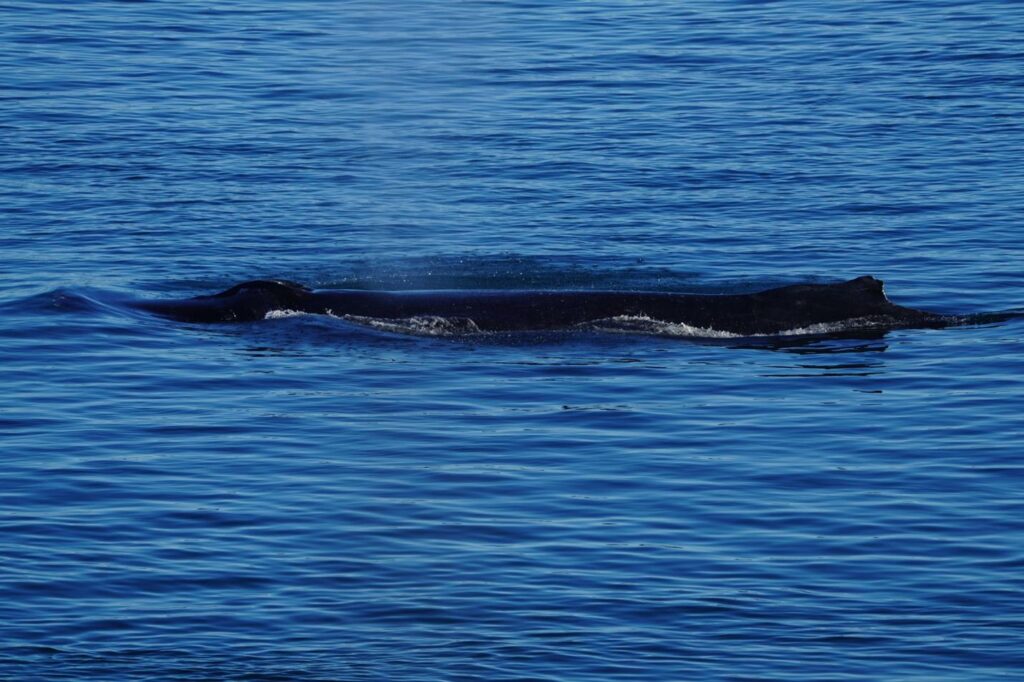
Humpback whale BCX1658 Bullet off the coast of Saturna Island. Photograph credit score: Lauren Laturnus
Dr. Pleasure has additionally just lately developed a collaborative relationship between her laboratory and the QENTOL, YEN (W̱SÁNEĆ Marine Guardians). This partnership focuses on the implementation of Indigenous science to enhance restoration initiatives for whales with anticipation that the Authorities of Canada will start to acknowledge the significance of Indigenous science.
I’m one in all Dr. Pleasure’s grasp’s college students and I had a front-row seat whales final summer time! My analysis seems to be on the totally different strategies, each handbook and automated, for monitoring whales and vessels, and the way they can be utilized to enhance whale restoration initiatives. With assist from my analysis companion, Rachel, and different members of Dr. Pleasure’s lab, I tracked whales and vessels utilizing a tool referred to as a theodolite. When calibrated and used accurately, a theodolite can present a dependable coordinate of the whale or vessel and place it on a map. Vessels within the ISZ have been reported to authorities, and all whales have been reported to the Whale Report app run by Ocean Smart.
One other detection technique I’m reviewing is the Southern Gulf Islands Whale Sighting Community, the citizen-science monitoring program, sponsored by SIMRES. Because of the fundraising for gear and ongoing coaching, these devoted volunteers have gear and information that permits them to make correct reviews of whales and vessels that illegally fish or journey within the ISZ. Their reviews contribute to the understanding of whale exercise within the space and drastically help with the enforcement of the ISZ.
As for automated detection techniques, SIMRES operates hydrophones (underwater microphones) in and close to the ISZ. The audio recordings can be utilized to establish the presence of various species, ecotypes, and pods. Fisheries and Oceans Canada, in partnership with SIMRES, employs two thermal cameras that may detect the warmth emitted from a whale once they floor, and a radar digital camera for monitoring vessels. Yet one more technical technique is that some vessels are required to have an Automated Identification System (AIS) that tracks their location, and a few select to take action voluntarily. When these vessels’ areas are detected throughout the ISZ, they’re mechanically reported.
A query usually requested is: what’s one of the simplest ways to watch whales? There isn’t one technique of monitoring that outshines the remaining, neither is there a single group that has all of the options. In the case of whale analysis, it’s concerning the energy of collaboration, particularly as a result of Canada set a aim to preserve 30% of our oceans by 2030.
Nature Canada, with different environmental teams, has recognized the Southern Strait of Georgia as a precedence marine space needing safety as a part of the pathway to attaining 30×30. Partnerships with First Nations and organizations reminiscent of SIMRES assist present information on this essential and threatened marine ecosystem. From my perspective, after we all work collectively to guard the marine ecosystem, the longer term survival of those whales turns into a bit brighter.
To be taught extra about SIMRES’ analysis within the Salish Sea, entry the unimaginable SGIWSN whale sightings database or hearken to one in all SIMRES hydrophones dwell, go to simres.ca.
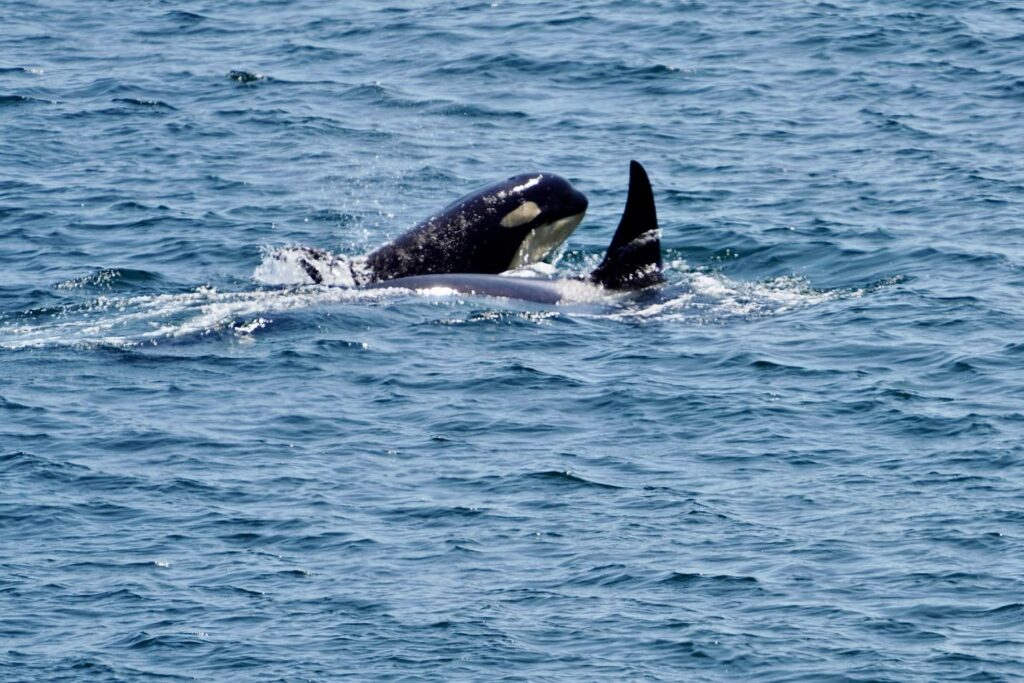
One of many two calves born in L-pod of the Southern Resident killer whales in 2023 swimming intently to an grownup killer whale, possible its mom. Photograph credit score: Rachel Fairfield Checko
[ad_2]

